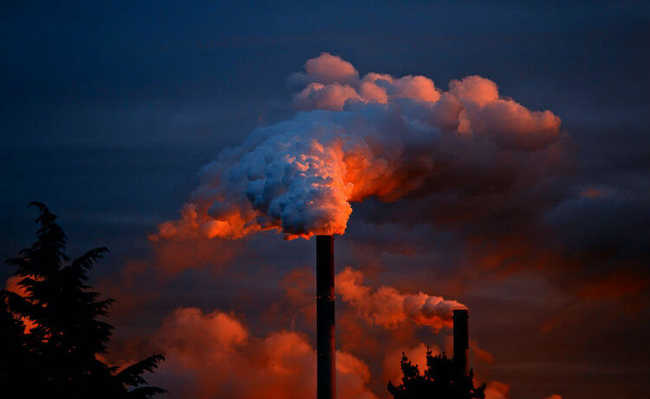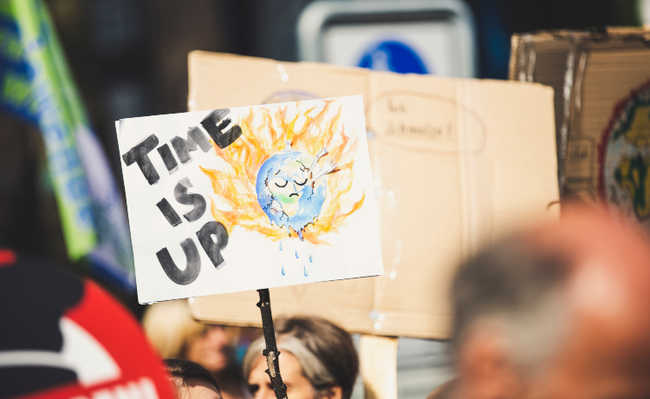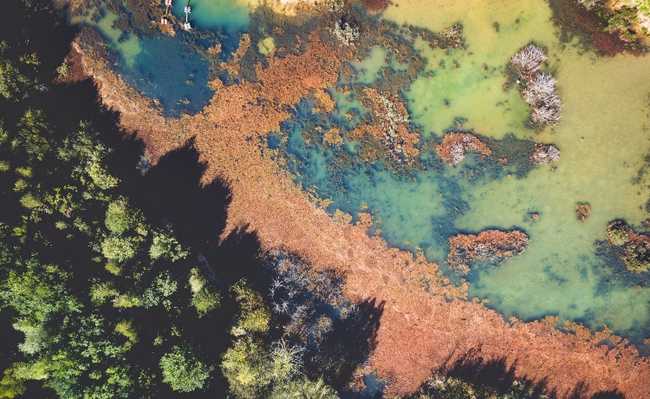What is Anthropocene?
Anthropocene is a new geological period, also called the "Age of Humanity"

We are living on the threshold of a new era. And, following the argument that human action has drastically altered the planet's natural functioning and fluxes by promoting intense global changes, several experts claim that we have entered a new geological epoch, the Anthropocene .
The findings of this argument are visible everywhere the human species passes or settles. And some evidence of this so-called 'Age of Humanity' and or 'Anthropocene Era' can be seen with the pollution of rivers and oceans by microplastics and different chemicals, the change in nitrogen levels due to the extensive use of fertilizers in agriculture, the increase in dispersion of radioactive substances on the planet, after many tests with nuclear bombs, and, above all, climate change, discussed in the highest spheres of world politics.
- What is climate change in the world? There are microplastics in salt, food, air and water
- What are fertilizers?
What is the Anthropocene?
This concept is the object of intense discussion in scientific circles. For scientists who defend the officialization of the transition to the Anthropocene, the human influence on the planet would have permanently impacted the Earth, to the point of justifying the adoption of a new geological epoch that characterizes its activity.
Coined by biologist Eugene Stoermer in the 1980s and popularized by Nobel Prize in Chemistry, Paul Crutzen, in 2000, the term Anthropocene has Greek roots: "anthropos" means man and "cenos" means new. This suffix is used in geology to designate all epochs within the period we currently live in, the Quaternary.
The observed global changes, driven by increasing and intense human action, led Paul Crutzen to propose that these anthropogenic activities would have affected the planet so profoundly that we should 'emphasize the central role of humanity in geology and ecology', recognizing that since the At the end of the 18th century, we experience a new geological period, the Anthropocene.
They, who first spoke in Anthropocene, indicated the beginning of this period as the beginning of the Industrial Revolution. Period in which dependence on burning fossil fuels caused an increase in carbon dioxide emissions, affecting the global climate by interfering with the natural warming mechanism of the greenhouse effect.
At the moment, we would live, therefore, the officialization of the passage from the Holocene to the Anthropocene.
The Holocene was the period of environmental stability experienced since the last glaciation – which ended approximately 11,000 years ago – during which humanity grew and developed. The Anthropocene would then be the new and current geological epoch in which this stability is being progressively lost due to the actions of humanity, which has become the main vector of change on planet Earth.
The transition from the Holocene to the Anthropocene period, in the name of a new epoch, implies a choice (not only scientific, but also political) that places the change in the functioning of the planet under the responsibility of the human species.
Pre-Anthropocene Phases
Hypothesis of the prehistoric phase

Evidence suggests that ancient humans (homo erectus), used fire to modify their environment and cook food, between 1.8 million years and 300,000 years ago, which would have influenced both the evolution of the species and the growth in brain size.
The most widely accepted thesis currently states that modern humans (homo sapiens) evolved in Africa approximately 200,000 years ago and have since migrated to other continents. It is recognized that these humans have played an important role in altering biodiversity and landscapes on islands and continents for at least the last 50,000 years.
They have been named, for example, as responsible for the decline and often total extinction of hundreds of species of large mammals (called megafauna) across North and South America, Eurasia, Australia and on many oceanic islands . Only in Africa and in the oceans has megafauna partly escaped large-scale extinction. Despite this, hundreds of large mammal species are currently under intense pressure on the African continent.
However, even though humans have contributed to the increase in the extinction rates of megafauna (through hunting and habitat alteration), climate change is also indicated as possible culprits. Therefore, when considering megafauna extinctions around the world, it seems likely that both climate and anthropogenic activity acted in concert.
agricultural revolution

The expansion of agriculture into multiple regions around the planet has had significant impacts on landscapes, biodiversity and atmospheric chemical composition since the beginning of the Holocene.
The 'Neolithic Revolution', about eight thousand years ago, opened the way for the clearing of large areas of forests and the burning of these lands for the improvement of agricultural lands. This fact raises the hypothesis that this drop in forests would have led to a general increase in carbon dioxide (CO2) in the atmosphere, contributing to an increase in global temperatures, albeit in a reduced way.
- Organic urban agriculture: understand why it's a good idea
About three thousand years after this reported scenario, agricultural expansion in Southeast Asia has led to widespread rice cultivation in flooded fields and, possibly, to global increases in methane (CH4) concentrations. Although there is still debate about the contribution of these land use practices to the early concentrations of greenhouse gases in the atmosphere during the Holocene, the increasing human landscape alteration is increasingly recognized.
Anthropocene Phases
First phase
According to Crutzen, this new geological period began around 1800, with the arrival of industrial society, characterized by the massive use of hydrocarbons (mainly oil for energy production and as a source of raw materials). Since then, the concentration of carbon dioxide in the atmosphere, caused by the combustion of these products, has not stopped growing. And there are still many lines of research that indicate that the accumulation of greenhouse gases contributes as a strong aggravating factor for global warming (learn more in the article "What is global warming?").

Thus, it is considered that the first phase of the Anthropocene goes from 1800 to 1945 or 1950 and corresponds, therefore, to the formation of the industrial age.
For much of human history, levels of population growth and energy consumption have been kept in check. The main reason was that societies have inefficient mechanisms for supplying energy, largely dependent on natural forces (such as wind and running water) or organic fuels such as peat and coal.
A major turnaround would have occurred when the Scottish inventor James Watt made improvements to the steam engine, at the end of the 18th century, allowing for greater efficiency in the energy generation process. This fact contributed to the beginning of the Industrial Revolution.
This transformation could be seen through many examples. One of them was the fact that, for the first time, it was possible to use enough energy to chemically generate fertilizers from atmospheric nitrogen. In this way, literally getting nutrients directly from the air. This made it possible to raise the productivity of agricultural lands, and, together with advances in medicine, ensured a great increase in human populations.
The intense burning of fossil fuels has led to a consequent increase in the levels of greenhouse gases in the atmosphere, especially carbon dioxide (CO2). The intensification of agricultural practices led to an increase in the levels of methane (CH4) and nitrous oxide (N2O) in the atmosphere.
The intensification of fossil fuel use and agricultural activities has also led to the production of large amounts of sulfur dioxide (SO2) and nitrous oxides (NOx). And, once in the atmosphere, these compounds convert to sulfate (SO4) and nitrates (NO3) and cause acidification of terrestrial ecosystems and fresh waters.
Acidification has been especially problematic in regions where the geology of the catchment is shallow and thin and can more easily contaminate freshwater sources. Continental-scale changes in freshwater diversity have been recognized since the early 1980s, and although international legislation has been adopted to reduce this process, biological recovery is hampered by climate change.
Second level

The second phase runs from 1950 to 2000 or 2015 and has been called “The Great Acceleration”. Between 1950 and 2000, the human population doubled from three billion to six billion people and the number of cars went from 40 million to 800 million! The consumption of the richest stood out from the rest of humanity, fueled by the geographic availability of abundant and cheap oil in the post-World War II context (also called the Cold War) and by the diffusion of innovative technologies that catalyzed a vast process of mass consumption (like modern cars, TVs, etc.).
In the current second phase of the Anthropocene Era (1945-2015), there was a considerable acceleration of exaggerated human activities on nature. “The big acceleration is in a critical state,” Crutzen said, because more than half of the services provided by terrestrial ecosystems are already facing degradation.
It is noteworthy that, in the period after World War II, intelligent and global communication and finance networks were created. Several country representatives gathered in Bretton Woods, New Hampshire, USA, in 1944 (still before the end of World War II), to rebuild the global economy among the countries of the capitalist bloc. This conference led to the creation of the International Monetary Fund, and eventually the World Bank.
The aforementioned conference also allowed for the exchange of knowledge between several international scientists and engineers, allowing the realization of technological advances, such as the development of nuclear energy and the construction of oil platforms in deep waters (which also ended up proving to be problematic in environmental terms) .
In the early 1960s, agricultural subsidies were widely distributed around the globe. This has resulted in intensive land use and constant application of fertilizers, promoting rapid nutrient enrichment in freshwater ecosystems and diminishing biodiversity.
The change in the way energy is consumed and the way the population grew was so dramatic after World War II that this period came to be known as the "Great Acceleration".
The impacts on the environment, characteristic of this time, include the accelerated increase in the emission of greenhouse gases, the rapid increase in coastal pollution and the exploitation of fisheries, and the worrying increases in the number of extinct species. These impacts were mainly due to population growth, high energy consumption and changes in land use.
In a third phase, from 2000 or, according to some, from 2015, humanity became aware of the Anthropocene. In fact, from the 1980s onwards, human beings began to progressively become aware of the dangers that their high-standard productive activity generated for planet Earth... And also for the species itself, since, with the destruction of natural resources , she would not be able to survive.
Global efforts in this geological period
Paul Crutzen and some experts have detailed the impacts that mark the entry into the Anthropocene. And according to them, after having modified our environment as never before, disturbing the climate system and deteriorating the balance of the biosphere, we humans, transformed into a “planetary geophysical force”, should act quickly to try to limit the damage.
In 2015, the world followed the Paris Agreement to define objectives and practical measures to contain the observed global changes. “In a sense, the agreement signals the almost unanimous recognition among the countries of the world that an urgent change is needed at the global level to alter the speed with which humanity is interfering with the planet's natural cycles. The challenge is to stabilize the climate system in a short period of time, which is perhaps the biggest obstacle that humanity has collectively faced”, said Carlos Nobre, Brazilian researcher at the Working Group on the Anthropocene (AWG).
For the AWG scientists, the next step towards the officialization of the new geological epoch is to define the markers and a date that will be considered as the official beginning of the epoch of humanity.
Climate change and global conflicts
Today we see an explosive combination between the global dilemmas of ecological crisis and inequality. A group of two billion people has a high consumption standard and appropriates the consequent material benefits, while four billion live in poverty and one billion in absolute misery. In this context, conflicts and disasters become imminent.
A report prepared by the Center for Climate and Security (Center for Climate and Security) identifies twelve “epicenters” where climate change can pressure global security, causing conflicts around the world. Many of these epicenters result from the scarcity of natural resources and the displacement of populations, but experts also consider the probability of nuclear war and the occurrence of pandemics, as decisive factors in defining these places at risk of conflict.
An example of this risk is island nations such as the Maldives, which could disappear under rising sea levels. This would certainly represent a crisis for the international community, which has never dealt with a disappeared state and has no legal standards for the resettlement of refugees in that situation. Another example examined was the increase in nuclear risk if reactors re-spread in an attempt to reduce fossil fuel emissions.
In the coming years, problems related to access to water and its scarcity may also represent challenges and conflicts in territories. Non-state actors are already seeking domination over water to control local populations (such as the diversion of scarce water courses). It has already been possible to observe friction between Egypt and Ethiopia over the use of the Nile River.
In an article in the journal Scientific American, Francsico Femia, president of the Center for Climate and Security, adds an optimistic phrase about how the government team of the President of the United States and denial Donald Trump will deal with these risks: “(...) You will see that many things will no longer be called 'climatic', but I don't think that the work (of dealing with these threats) will really stop”.
If you want to delve even further into the links between climate change and global conflicts, a comprehensive literature review has been published to get at the main statistical evidence on this issue. This review was prepared by Adelphi.
Check out a video (with narration in English) about the Anthropocene. To learn more about it, go to: "Welcome to the Anthropocene: Video shows the effects of humankind's action on Earth."










